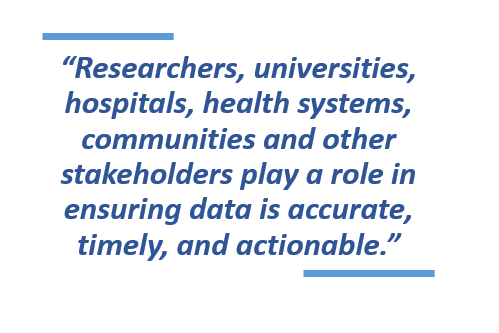Race and COVID-19: Where do we go from here?
COVID-19 exposed significant racial and ethnic health inequities in our U.S. health system. The current pandemic demonstrates the structural challenges we must overcome as health professionals to ensure equitable access to health-promoting services and the role data collection can play.
Pursuing health equity means striving for the highest possible standard of health for all people and giving special attention to the needs, resources, and opportunities of those at greatest risk of poor health. During the early stages of the pandemic, only a small share of testing sites were in communities of color and the barriers to receiving tests were high due to little or no health insurance or strict provider requirements, such as doctor referrals, appointments, and symptoms consistent with infection.
The differential access also illuminated limited data linkages as well as the issue that federal race and ethnicity COVID-19 data is not comprehensive enough to represent the experiences of everyone. Currently, the federal government does not provide race and ethnicity data related to testing, which impacts our understanding of accessibility, availability, and the true burden of COVID-19 among people of specific races or ethnicities. Very little federal hospitalization data includes race and ethnicity information and not all states release data on the race and ethnicity of vaccine recipients. While COVID-19 data is reported on cases, mortality, and select geography, it can be difficult to act upon in a meaningful way if it is not comprehensive, timely, and representative.
upon in a meaningful way if it is not comprehensive, timely, and representative.
Any strategy to advance health equity requires we systematically identify, analyze, and make available data about health threats, set priorities, mobilize partners, and drive improvement activities. In order to obtain equity-oriented data, we need to address technology gaps, limitations in data systems, compatibility between sectors, and barriers to what should be shared. There are also concerns related to staff capacity, privacy, and the need to promote national standards for data collection which take into account communities who have experienced greater social or economic obstacles to health based on race, religion, socioeconomic status, gender, mental health, physical disability, sexual orientation, geography or other characteristics linked to discrimination or exclusion.
There are numerous opportunities for building a framework to obtain meaningful data. Coronavirus vaccine mobile apps and dashboards have aided in tracking symptoms, providing the latest updates, and more. State and national government as well as philanthropy can incentivize a focus on health equity when improving data systems capacity, compatibility, and analytic ability. We can also use integrated and relevant contextual data to improve community outcomes (e.g. Community Health Assessment) or leverage experiences from other sectors where model data sharing is being done. Researchers, universities, hospitals, health systems, communities and other stakeholders play a role in ensuring data is accurate, timely, and actionable. We can use mapping, existing collection efforts, and analysis to tell a story of what’s possible, what’s working, and where gaps exist.
To meet the needs of diverse populations, our health system must begin the work of bridging siloed data collection methods toward a core public health data infrastructure that facilitates automatic, interoperable data exchange. The first and hardest step is to stop admiring the problem and start doing the work. This could not only evolve our health system into one that provides better health, but one that ensures provisions for all.

